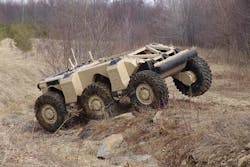U.S. Army Investing in Unmanned Vehicles
Recent analysis by research firm Frost & Sullivan reveals that the U.S. Army is significantly investing in its aging combat vehicle (CV) fleet to include manned and unmanned vehicles. As detailed in the report “US Military Combat Vehicle Market, Forecast to 2024,” development of robotics and autonomous systems will help boost combat efficiency and the effectiveness of the CV fleet while leveraging advanced sensors for many opportunities for automated weapons systems. Frost & Sullivan expects the cumulative spending by the Department of Defense (DoD) on CVs to reach $56.25 billion by 2024.
“Technology upgrades and modifications are the stable spending segments as wear and tear of systems and developing defense mechanisms for evolving threats are essential areas of focus,” said John Hernandez, senior industry analyst, defense at Frost & Sullivan. “In the near future, the U.S. Army will look toward long wave infrared (LWIR) sensors with extended field of view and capable of providing high-definition video to enhance situational awareness in support of military CV.”
The somewhat crowded marketplace for military autonomous vehicles and military contracts is currently dominated by the top five suppliers, including BAE Systems and General Dynamics.
“To contend in a highly established and consolidated market, OEMs need to start restructuring their platforms with a focus on open architecture,” observed Hernandez. “Benchmarking winning modular designs, improving their capabilities by building affiliations that complement their capabilities with a variety of options, and ensuring user requirements are met will be key to future success.”
Moving forward, companies will be able to fuel the Army’s CV modernization strategy while also providing lighter, more reliable vehicles. System houses that can develop sensor architectures that contribute to longer operating times with higher reliability will be part of that plan. “Although there are significant prospects in this market, it is difficult to enter, with incumbent contractors well-established with strong supply chain capabilities and logistics management expertise,” said Hernandez. “Furthermore, U.S. involvement in past wars has taken its toll on equipment and slowed efforts to modernize.”
About the Author
Jack Browne
Technical Contributor
Jack Browne, Technical Contributor, has worked in technical publishing for over 30 years. He managed the content and production of three technical journals while at the American Institute of Physics, including Medical Physics and the Journal of Vacuum Science & Technology. He has been a Publisher and Editor for Penton Media, started the firm’s Wireless Symposium & Exhibition trade show in 1993, and currently serves as Technical Contributor for that company's Microwaves & RF magazine. Browne, who holds a BS in Mathematics from City College of New York and BA degrees in English and Philosophy from Fordham University, is a member of the IEEE.

